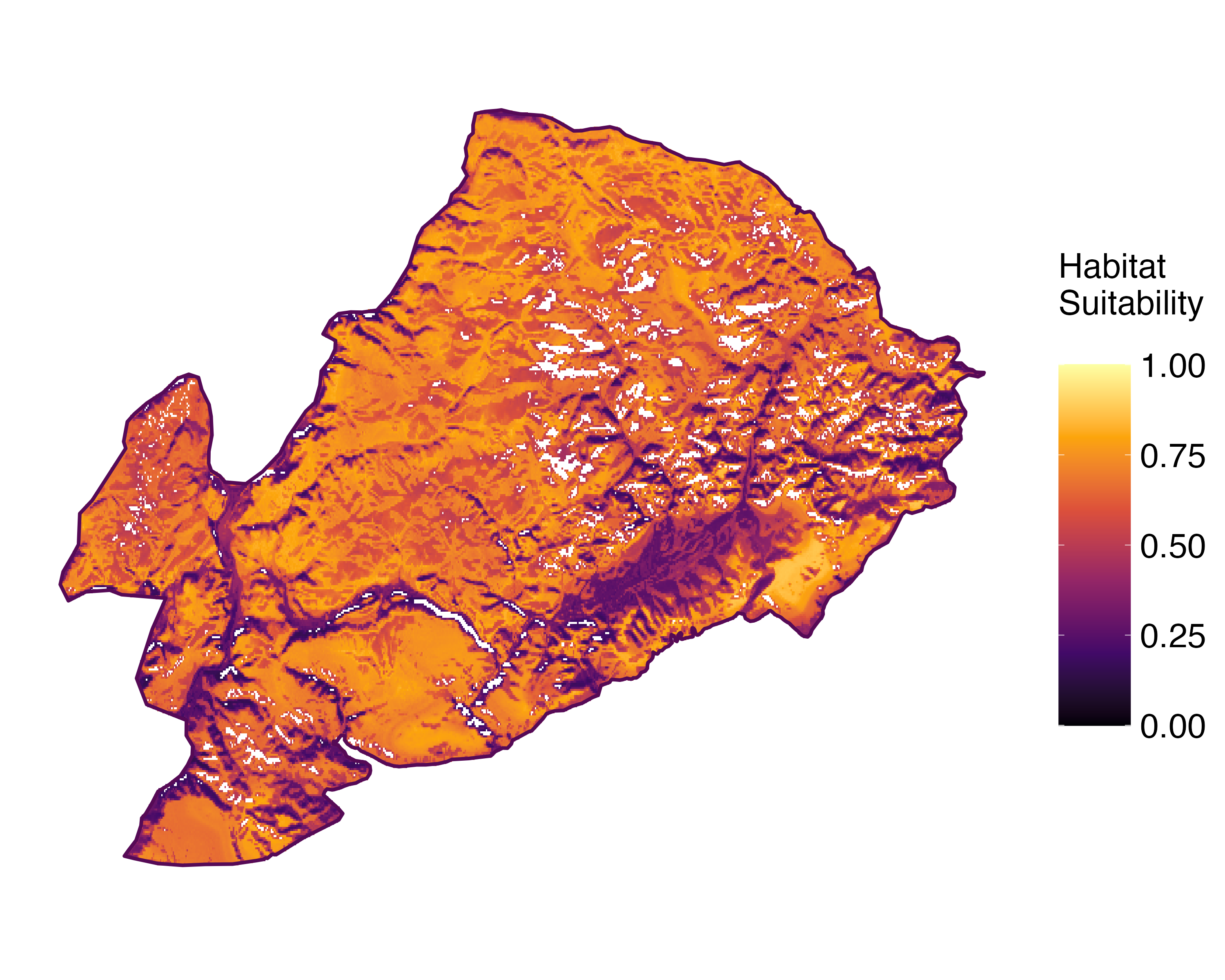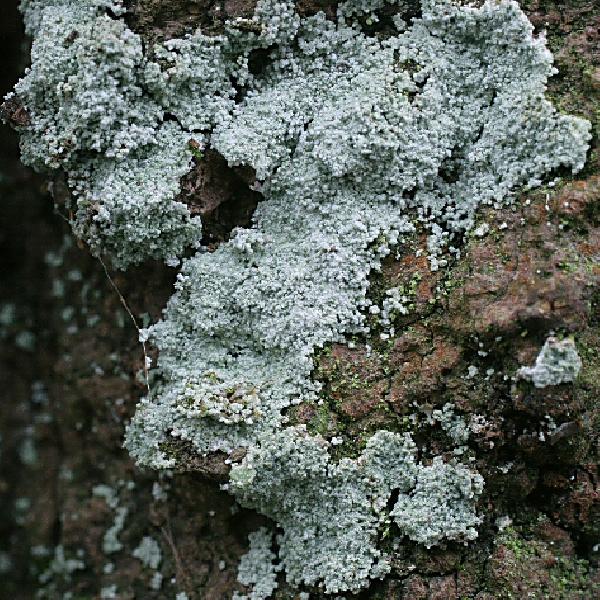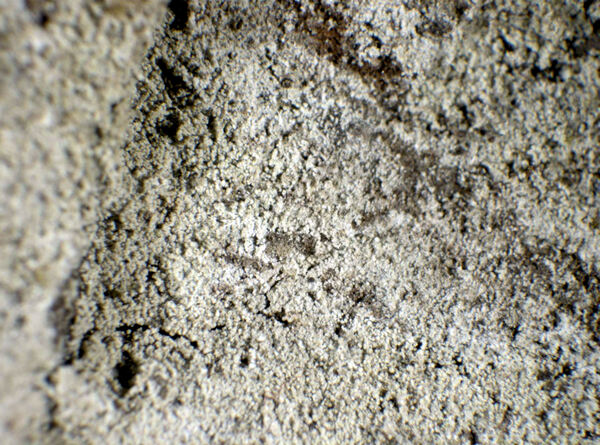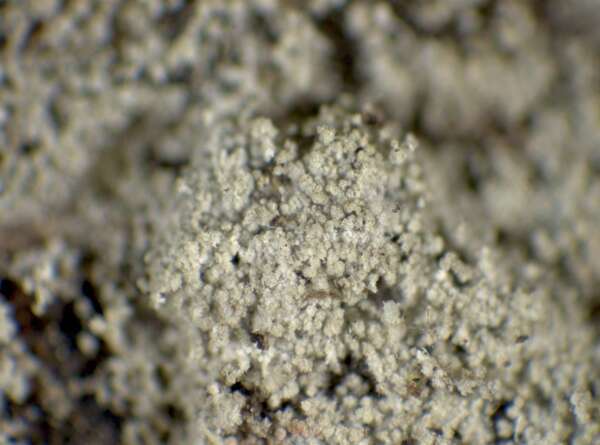Lepraria incana (L.) Ach.
Meth. Lich.: 4, 1803. Basionym: Byssus incana L. - Sp. Pl., 2: 1169, 1753.
Synonyms: Crocynia crassissima Hue non auct.; Crocynia maritima B. de Lesd.; Lepra sulphurea (Schltdl.) Ehrh.; Lepraria aeruginosa auct. p.p.; Lepraria crassissima (Hue) Lettau non auct.; Lepraria glaucella (Flörke) Ach.; Patellaria incana (L.) Spreng.
Description: Thallus leprose, cottony, greenish/bluish grey to whitish grey, often with dull orange, orange-brown or pale orange-brown areas which react K+ purple-red, diffuse and not sharply delimited, without marginal lobes, consisting of a thick, soft mass of powdery, spherical, (20)30-70(-100) µm wide, ecorticate granules with a rather firm surface developing upon a shared hypothallus, delimited by a byssoid-arachnoid prothallus forming an irregular, not distinctly lobed margin, without or with very short projecting hyphae. Medulla white, poorly developed to absent, the hyphae 2-5 µm thick. Photobiont chlorococcoid, the cells c. 18 µm wide. Spot tests: K- or K+ dirty yellow, C-, KC-, P-, UV+ bright bluish white, sometimes also patchily UV+ pale orange, the orange parts K+ purple-red. Chemistry: divaricatic acid, zeorin, sometimes also parietin, irregularly distributed in the thallus.
Growth form: Leprose
Photobiont: green algae other than Trentepohlia
Reproductive strategy: mainly asexual, by soredia, or soredia-like structures (e.g. blastidia)
In underhangs rarely wetted by rain
Commonnes-rarity: (info)
Alpine belt: absent
Subalpine belt: very rare
Montane belt: rather common
Dry submediterranean belt: rare
Humid submediterranean belt: rare
Padanian area: very rare
pH of the substrata:
1 2 3 4 5
Solar irradiation:
1 2 3 4 5
Aridity:
1 2 3 4 5
Eutrophication:
1 2 3 4 5
Poleotolerance:
0 1 2 3
Altitudinal distribution:
1 2 3 4 5 6
Rarity
absent
extremely rare
very rare
rare
rather rare
rather common
common
very common
extremely common
Loading data...
Occurrence data
Predictive map
 Current prediction (1981-2010)
Current prediction (1981-2010) Future prediction (2071-2100) SSP 1-2.6
Future prediction (2071-2100) SSP 1-2.6 Future prediction (2071-2100) SSP 5-8.5Predictive maps according to Francesconi et al. 2025
Future prediction (2071-2100) SSP 5-8.5Predictive maps according to Francesconi et al. 2025
Growth form: Leprose
Photobiont: green algae other than Trentepohlia
Reproductive strategy: mainly asexual, by soredia, or soredia-like structures (e.g. blastidia)
In underhangs rarely wetted by rain
Commonnes-rarity: (info)
Alpine belt: absent
Subalpine belt: very rare
Montane belt: rather common
Dry submediterranean belt: rare
Humid submediterranean belt: rare
Padanian area: very rare
pH of the substrata:
| 1 | 2 | 3 | 4 | 5 |
Solar irradiation:
| 1 | 2 | 3 | 4 | 5 |
Aridity:
| 1 | 2 | 3 | 4 | 5 |
Eutrophication:
| 1 | 2 | 3 | 4 | 5 |
Poleotolerance:
| 0 | 1 | 2 | 3 |
Altitudinal distribution:
| 1 | 2 | 3 | 4 | 5 | 6 |
Rarity
absent
extremely rare
very rare
rare
rather rare
rather common
common
very common
extremely common
Loading data...
Occurrence data
Predictive map
 Current prediction (1981-2010)
Current prediction (1981-2010) Future prediction (2071-2100) SSP 1-2.6
Future prediction (2071-2100) SSP 1-2.6 Future prediction (2071-2100) SSP 5-8.5
Future prediction (2071-2100) SSP 5-8.5Predictive maps according to Francesconi et al. 2025










